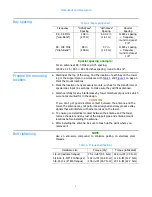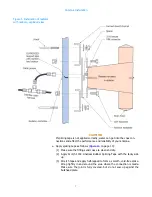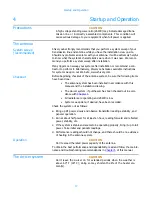
3
Antenna Installation
2
Antenna Installation
Precautions
WARNING
Don't expose personnel to the medical hazards of intense radio fre-
quency (RF) radiation. Whenever working on the tower in the area of
the antenna, turn off all transmitters and lock them out so that they can-
not be turned on accidentally.
Installing the support
pipe
The 6812DIN antenna is designed to mount on a customer-supplied vertical
pipe, which in turn is mounted on the tower. Mounting is a little different for
side-mounted poles and top-mounted poles.
The pipe must be between 2-3/8” and 3-1/2” (60 and 89 mm) nominal out-
side diameter. It must extend at least five feet (1500 mm) above the top bay
and five feet below the bottom bay.
NOTE
Shively can accommodate other pipe sizes if necessary by special order.
Side-mounted support pipe
Mount your support pipe securely as shown in
. It must stand off from
the tower as described in
Figure 1. Support pipe
installation
Follow these guidelines:
a. To ensure good electrical contact between the support pipe and the tower,
remove the tower paint and any rust at the support pipe mount locations
before installing the mounts. After installing the mounts, be sure to touch up
the paint where you removed it.
b. Starting at the top of the support pipe, mark the location of each bay in
accordance with the installation drawing.
c. Also, mark the specified location of any accessory mounts (eg: de-icer box
mounts), to make sure they will fit as planned.
Table 3. Side-mounted support pipe standoff from tower
Tower Face "A"
Standoff "B"
less than 24" (610 mm)
12" (305 mm)
24" - 60" (610 - 1500 mm)
24" (610 mm)
over 60" (1500 mm)
36" (915 mm)
CAUTION
If you don't get good elec-
trical contact between the
mounts, the support pipe,
and the tower, the
antenna may not perform
as designed and may pro-
duce stray signals that will
interfere with other ser-
vices on the tower.
Important
Improper antenna mount-
ing is a leading cause of
poor
performance
in
6812DIN antennas. It is
very important to install
the antenna as indicated
and to position it away
from other metallic struc-
tures.










































